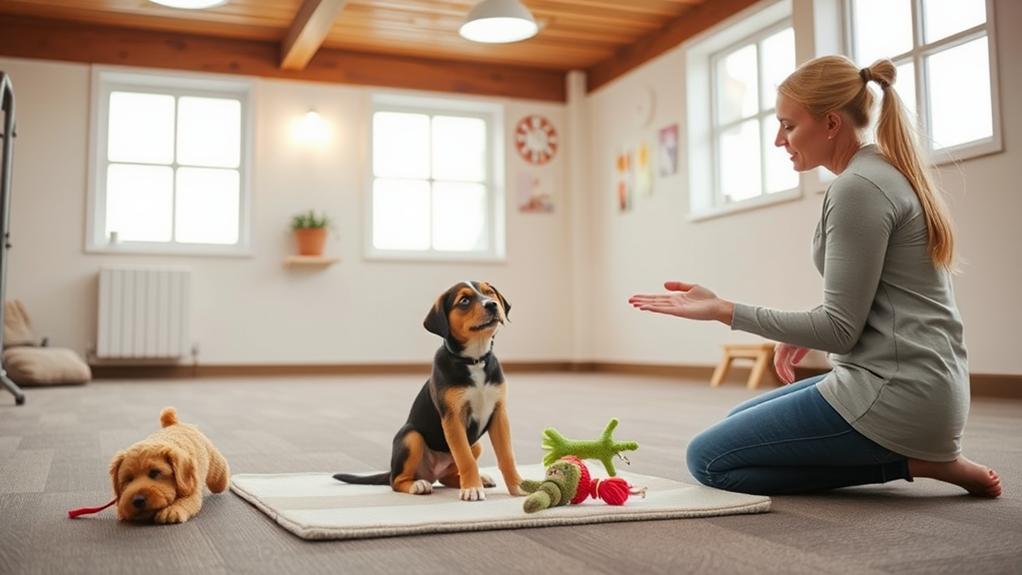Many people underestimate how deeply anxiety can affect a puppy's behavior and overall well-being. It's vital to recognize that anxious pups require a tailored approach to training that differs from more confident dogs. You might be wondering how to effectively help your furry friend conquer their fears while building a strong bond. Understanding your puppy's unique needs is just the beginning; there are specific strategies that can really make a difference in their training journey. Interested in discovering these essential tips?
Understand Your Puppy's Anxiety
Many puppies experience anxiety, and recognizing the signs is essential to helping them feel secure. You might notice your puppy exhibiting behaviors like excessive barking, trembling, or hiding when faced with new situations or loud noises.
Pay attention to their body language; a tucked tail, flattened ears, and wide eyes can indicate stress. Understanding these cues allows you to respond appropriately.
Anxiety can stem from various sources, such as separation from their mother, unfamiliar environments, or past traumatic experiences. If your puppy seems uncomfortable around new people or pets, it's vital to give them space and let them approach at their own pace.
You should also consider their daily routine and how it affects their emotional well-being. Regular exercise, mental stimulation, and a consistent schedule can help reduce anxiety levels.
Keep in mind that every puppy is unique. What triggers anxiety in one mightn't affect another. By closely observing your puppy's reactions, you can identify specific triggers and work to desensitize them gradually.
Being patient and empathetic is key as you help your furry friend navigate their fears and build confidence over time.
Create a Safe Space
Creating a safe space for your anxious puppy is essential for their comfort and security. Start by choosing a quiet area in your home where your puppy can retreat when they feel overwhelmed. This space should be away from loud noises, foot traffic, and other distractions.
Next, furnish the area with cozy bedding, toys, and items that smell like you. A soft blanket or a crate can help create a den-like environment, which many dogs find comforting. Be sure to keep this space consistent so your puppy knows where to go when they need a break.
You can also use barriers like baby gates to limit access to this safe zone, helping your puppy feel secure.
Consider adding some calming elements, like a white noise machine or gentle music, to drown out any sudden noises that could trigger anxiety.
Use Positive Reinforcement
Once your puppy has a safe space to retreat to, it's time to focus on training techniques that can help ease their anxiety. Positive reinforcement is one of the most effective methods you can use. This technique involves rewarding your puppy for desired behaviors, which encourages them to repeat those actions.
Start by identifying what motivates your puppy—this could be treats, praise, or toys. Whenever your puppy exhibits calm behavior or approaches a new situation without fear, immediately offer them a reward. This helps them associate positive experiences with what they might initially perceive as stressful.
Be consistent with your rewards. If your puppy gets anxious during training, break tasks into smaller steps. For example, if your puppy's scared of a particular sound, play it softly while rewarding them for staying calm. Gradually increase the volume as they become more comfortable.
Establish a Routine
Establishing a routine can greatly reduce anxiety in your puppy by providing a sense of predictability and security. When your puppy knows what to expect, it helps them feel more comfortable in their environment.
Start by setting consistent times for feeding, potty breaks, and playtime. This regularity helps your puppy understand their daily schedule, which can ease their worries.
Make sure to include training sessions within this routine. Short, positive training exercises help reinforce good behavior while also giving your puppy a sense of accomplishment. This structure is essential for anxious dogs, as it provides them with clear expectations.
In addition to daily activities, consider incorporating calming rituals. For example, you might have a specific time each evening for quiet cuddling or gentle grooming. These moments can help your puppy unwind and feel secure.
Don't forget to be patient. It may take time for your puppy to adapt to the routine. Consistency is key—stick to your schedule as much as possible.
As your puppy grows more comfortable, you'll likely notice a decrease in their anxiety levels, making training easier and more enjoyable for both of you.
Socialize Gradually
As you work to reduce your puppy's anxiety, socializing them gradually is essential for building their confidence and comfort around new experiences. Start by exposing your puppy to a variety of environments, sounds, and people in a controlled manner. This way, they can learn to feel secure without feeling overwhelmed.
Here's a simple table to guide your gradual socialization process:
| Step | Activity | Duration |
|---|---|---|
| 1 | Short walks in quiet areas | 5-10 minutes |
| 2 | Meet one calm dog | 10-15 minutes |
| 3 | Visit a friend's home | 15-20 minutes |
| 4 | Attend a small puppy class | 20-30 minutes |
| 5 | Explore a busy park | 30-45 minutes |
Remember to observe your puppy's body language throughout these activities. If they show signs of stress, take a step back and allow them to acclimate. Gradual exposure helps them associate new experiences with positive feelings, making future encounters less intimidating.
Keep Training Sessions Short
Keeping training sessions short is essential for maintaining your puppy's focus and enthusiasm. Anxious dogs can easily become overwhelmed, so limiting your sessions to about 5 to 10 minutes can make a significant difference. This approach helps keep your puppy engaged without pushing them past their comfort zone.
Here are a few tips to make the most of your short training sessions:
- Choose a quiet environment: Pick a calm space free from distractions, allowing your puppy to concentrate on you and the task at hand.
- Focus on one command at a time: Target a single behavior during each session. This makes it easier for your puppy to grasp the concept and reduces their stress.
- End on a positive note: Always finish your session with a success. Whether it's a trick they've mastered or just a few minutes of playtime, this reinforces a positive experience.
Introduce Calming Techniques
Often, introducing calming techniques can greatly help anxious dogs during training. These methods create a soothing environment, allowing your puppy to focus better and feel more secure.
One effective technique is to use calming music or white noise. Playing soft, gentle tunes can drown out distracting sounds, helping your dog relax.
Another useful tactic is to incorporate aromatherapy. Scents like lavender or chamomile can have a calming effect on dogs. You can use essential oils in a diffuser or apply them to a bandana for your pup to wear. Always verify the oils are pet-safe and consult your vet if you're unsure.
Creating a designated safe space for your dog can also work wonders. This area should be quiet, comfortable, and filled with familiar items like their favorite blanket or toys. Encourage your pup to retreat to this space during training if they feel overwhelmed.
Lastly, practice gentle touch techniques. Petting your dog in a calm manner can help alleviate anxiety. Focus on areas like the chest or behind the ears, where many dogs enjoy being touched.
Be Patient and Consistent
Training an anxious puppy requires you to stick with it and remain consistent. Anxious dogs thrive on routine, so your patience will be essential in helping them feel secure.
It's important to understand that progress may be slow, but with your dedication, you'll make a significant impact on your puppy's confidence.
Here are a few key points to keep in mind:
- Set a Schedule: Regular training sessions help your puppy know what to expect and when. Aim for short, frequent sessions to reinforce learning without overwhelming them.
- Use the Same Commands: Consistency in language is important. Stick to the same verbal commands and signals, so your puppy can easily understand what you want from them.
- Celebrate Small Wins: Recognize and reward even the tiniest achievements. Positive reinforcement boosts your puppy's confidence and encourages them to keep trying.
Monitor Progress and Adjust
As you remain patient and consistent, it's important to regularly monitor your puppy's progress. Keep an eye on how your dog reacts to various situations. Are they becoming more comfortable with new environments or people? Note any improvements, no matter how small, as these victories show that your efforts are paying off.
Use a training journal to track your puppy's behavior over time. Record instances of anxiety, successful interactions, and any changes in their responses. This way, you can identify patterns and adjust your training techniques accordingly.
For example, if your puppy seems to struggle with a specific trigger, you might need to modify your approach, perhaps by introducing that trigger more gradually.
Don't hesitate to change your training methods if something isn't working. Flexibility is key in helping your anxious pup. Experiment with different rewards, training tools, or techniques.
Pay attention to your puppy's body language, as it can reveal their comfort level. By staying attuned to their needs and adjusting your strategies, you'll create a supportive environment that fosters growth and confidence in your furry friend.
Seek Professional Help
When anxiety becomes overwhelming for your puppy, seeking professional help can make a significant difference. A qualified trainer or behaviorist can provide tailored strategies to address your puppy's specific needs, ensuring a calmer, more confident companion.
They can guide you in creating a structured training plan and offer support throughout the process.
Here are three key benefits of professional help:
- Expert Guidance: You'll get insights into your puppy's behavior and triggers, making it easier to understand their anxiety.
- Customized Training Plans: Professionals can develop a plan that fits your puppy's unique personality and anxiety level, maximizing effectiveness.
- Support and Accountability: Regular sessions help keep you motivated and accountable, ensuring consistent progress.
Don't hesitate to reach out if your puppy's anxiety seems unmanageable.
Professionals have the experience and resources to help you navigate the challenges, ultimately leading to a happier and healthier relationship with your furry friend.
Conclusion
Training an anxious puppy can feel like a delicate dance, but every step you take brings you closer to a harmonious bond. With patience and understanding, you'll guide your furry friend through their worries, turning moments of anxiety into opportunities for growth. Remember, it's not just about teaching commands; it's about nurturing trust and confidence. Celebrate each small victory together, and know that with your love and support, your puppy will flourish in their own time.



